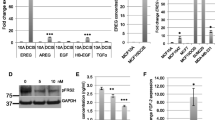Abstract
Background
There has been a recent surge of interest in the role of growth differentiation factors and other bone morphogenic proteins in the development and spread of cancer. In this study we have provided evidence that highlights the significance of growth and differentiation factor-9a (GDF-9a) and GDF-9b (bone morphogenic protein-15, BMP-15) in breast cancer development and progression.
Methods
Primary breast cancer samples (n = 109) and matched background tissues from same patients (n = 33) were processed for frozen section and RNA extraction. Frozen sections from matched tissues were immunostained with GDF-9a and GDF-9b antibodies. Staining intensity was analyzed by computer image analysis. RNA was reverse transcribed and quantified before analysis by quantitative polymerase chain reaction (Q-PCR). Results were expressed as number of transcripts (standardized by β-actin). The data were compared with the clinical outcome of the disease. The biological effects of the molecule were studied using in vitro assays after forced expression in breast cancer cells.
Results
Highly aggressive breast cancer cells did not express GDF-9a. On forced expression of GDF-9a, breast cancer cells became less invasive. These laboratory findings were analyzed against the clinical information. Primary breast cancer samples with good predicted prognosis had a significantly higher level of GDF-9a than in samples with poor predicted prognosis (P = .004). Patients who remained disease-free at the end of a 10-year follow-up had significantly higher levels of both GDF-9a and GDF-9b in their tissue than those with poor clinical outcome (P = .001 and .014, respectively).
Conclusion
Growth differentiation factor-9 family expressed in breast cancer has an inhibitory effect on the progression of human breast cancer.







Similar content being viewed by others
References
Pisani P, Parkin DM, Ferlay J. Estimates of worldwide mortality from eighteen major cancers in 1985. Implications for prevention and projections of future burden. Int J Cancer 1993; 55:891–903
Urist MR. Bone formation by autoregulation. Science 1965; 150:893–9
Dube JL, Wang P, Elvin J, Lyons KM, Celeste AJ, Matzuk MM. The bone morphogenetic protein 15 gene is X-linked and expressed in oocytes. Mol Endocrinol 1998; 12:1809–17
Phippard DJ, Weber-Hall SJ, Sharpe PT, Naylor MS, Jayatalake H, Maas R, Woo I, Roberts-Clarke D, Francis-West PH, Liu YH, Maxson R, Hill RE, Dale TC. Regulation of MSX-1, MSX-2, BMP-2 and BMP-4during foetal and post-natal mammary gland development. Development 1996; 22:2729–37
Wang EA, Rosen V, D’Alessandro JS, et al. Recombinant human bone morphogenetic protein induces bone formation. Proc Natl Acad Sci U S A 1990; 87:2220–4
Knabbe C, Lippman ME, Wakefield LM, Flanders KC, Kasid A, Derynck R, Dickson RB. Evidence of transforming growth factor-beta is a hormonally regulated negative growth factor in human breast cancer cells. Cell 1987; 48:417–28
Clement JH, Sanger J, Hoffken K. Expression of bone morphogenetic protein 6 in normal mammary tissue and breast cancer cell lines and regulation by epidermal growth factors. Int J Cancer 1999; 80(2):250–6
Schwalbe M, Sanger J, Eggers R, Nauman A, Schmidt A, Hoffken K, Clement JH. Differential expression and regulation of bone morphogenetic protein 7 in breast cancer. Int J Oncol 2003; 23(1):89–95
Arnold SF, Tims E, Mcgrath BE. Identification of bone morphogenetic proteins and their receptors in human breast cancer cells lines: importance of BMP2. Cytokine 1999: 11(12):1031–7
Lacroix M, Siwek B, Marie PJ, Body JJ. Production and regulation of interleukin-11 by breast cancer cells. Cancer Lett. 1998; 127:29–35
Kang Y, Seigel PM, Shu W, et al. A multigenic program mediating breast cancer metastasis to bone. Cancer Cell 2003; 3(6):537–49
Hanavadi S, Martin TA, Mansel RE, Jiang WG. Interleukin-11 and its receptor expression in human breast cancer. Ann Surg Oncol 2006; 13(6):802–8
Hanavadi S, Martin TA, Mansel RE, Jiang WG. Bone morphogenic protein (BMP)-15 is reduced by Interleukin-11 in human breast cancer cells. Breast Cancer Res Treat 2004; 88(Suppl 1):S248
Incerti B, Dong J, Borsani G, Matzuk MM. Structure of the mouse growth differentiation factor 9 gene. Biochim Biophys Acta 1994; 1222:125–8
McGrath SA, Esquela AF, Lee SJ. Oocyte-specific expression of growth differentiation factor-9. Mol Endocrinol 1995; 9:131–6
Galea MH, Blamey RW, Elston CE, Ellis IO. The Nottingham prognostic index in primary breast cancer. Breast Cancer Res Treat 1992; 22(3):207–19
Elston CW, Ellis IO. Pathological prognostic factors in breast cancer. 1. The value of histological grade in breast cancer: experience from a large study with long-term follow-up. Histopathology 1991; 19:403–10
Chomczynske P, Sacchi N. Single-step method of RNA isolation by acid guanidinium thiocyanate-phenol-chloroform extraction. Anal Biochem 1987; 162:156–159
Jiang WG, Watkins G, Lane J, Douglas-Jones A, Cunnick GH, Mokbel M, Mansel RE. Prognostic value of Rho family and rho-GDIs in breast cancer. Clin Cancer Res 2003; 9(17):6432–40
Davies G, Jiang WG, Mason MD. Cell–cell adhesion and signaling intermediates in human prostate cancer. J Urol 2000; 163:985–92
Aaltonen J, Laitinen MP, Vuojolainen K, et al. Human growth differentiation factor-9 (GDF-9) and its novel homolog GDF-9b are expressed in oocyte during early folliculogenesis. J Clin Endocrinol Metab 1999; 84:2744–50
Erickson GF, Shimasaki S. The role of oocyte in folliculogenesis. Trends Endocrinol Metab 2000; 11:193–8
Hayashi M, McGee EA, Min G, Klein C, Rose UM, van Duin M, Hsueh AJ. Recombinant growth differentiation factor-9 (GDF-9) enhances growth and differentiation of cultured early ovarian follicles. Endocrinology 1999; 140:1236–44
Acknowledgement
The authors wish to thank Cancer Research Wales (CRW) and Cancer Research UK (CR-UK) for supporting.
Author information
Authors and Affiliations
Corresponding author
Rights and permissions
About this article
Cite this article
Hanavadi, S., Martin, T.A., Watkins, G. et al. The Role of Growth Differentiation Factor-9 (GDF-9) and Its Analog, GDF-9b/BMP-15, in Human Breast Cancer. Ann Surg Oncol 14, 2159–2166 (2007). https://doi.org/10.1245/s10434-007-9397-5
Received:
Accepted:
Published:
Issue Date:
DOI: https://doi.org/10.1245/s10434-007-9397-5




